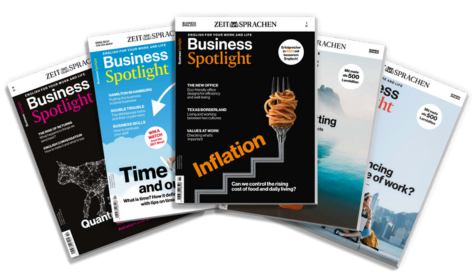Global challenges such as poverty, education, forced migration, health and climate change are so complex that no single person or group is likely to provide remedyAbhilfe(maßnahme)remedies to these problems. An innovative, collaborativeteamorientiertcollaborative method to find creative solutions to such problems is known as “design thinking.” While it originated with designers, today, design thinking is to utilize sth.etw. nutzenutilized by people from all disciplines. This approach has, for example, been used to improve the design of hospital emergency room (US)Notaufnahmeemergency rooms and student orientation programs at universities.
What is design thinking and why is it so popular?
To solve complex problems, design thinking focuses on practical results and solutions that are technically ffeasiblemachbareasible, economically viabletragfähigviable and desirable for users. It is a human-centered, team-based approach that requires certain mindsetDenkweise, Einstellungmindsets — including curiosity, empathy, radical collaborationZusammenarbeitcollaboration and biasTendenz, Ausrichtungbias toward action.
Curiosity: In its deepest sense, design thinking is about being curious — asking questions and to probe sth.etw. sondieren, untersuchenprobing deeper, questioning assumptionAnnahmeassumptions, asking why things are the way they are and why people behave the way they do. Being curious about our environment helps us build relationships with others and see problems from new perspectives.
Empathy: One of the greatest challenges in design thinking is to understand the people we are designing for. Design thinking is about stepping into the users’ shoes to understand why they think, feel and behave the way they do.
Radical collaboration: It takes many people with a variety of backgrounds and experiences to understand a problem and find an innovative solution. Design thinkers usually work in multidisciplinary teams and get inputhier: Anregungeninput from outside the team. This lets them approach a problem from various angleBlickwinkelangles.
Bias toward action: Design thinking is hands-onpraktisch; hier: aktivhands-on and favors action over discussion. Rather than making assumptions about what users want, design thinkers to engage with sb.mit jmdm. interagierenengage with them face-to-facedirektface-to-face. Instead of spending lots of time talking about potential solutions, they build prototypes and test them in the real world, making changes based on feedback.
What does design thinking look like in practice?
A variety of design-thinking frameworkhier: Systemframeworks are in use today, usually ranging from three to nine phases, but the underlying principles are always more or less the same. Design thinking is a non-linear, iterativeiterativ, sich schrittweise optimierenditerative process that lets teams understand users, challenge assumptions, redefine problems, and create and test solutions.
One of the leading practitionerAnwender(in)practitioners of design thinking is the Hasso Plattner School of Design Thinking in Potsdam, Germany, which uses a six-phase model: Understand – Observe – Define Point of View – ideateIdeen findenIdeate – Prototype – Test. While these phases appear to be sequential, design thinking is not a linear process. At any stage, new insightErkenntnisinsights may require the team to go back to an earlier phase and repeat the process.
Closer look
Worst Possible Idea
This is an ideationIdeenfindung, -entwicklungideation method in which team members are asked to think of the worst solutions to a problem. This process helps people relax as they’re less likely to worry about losing face, which can to stifle sth.etw. abwürgenstifle creativity. This form of ideation increases confidence and, very often, the number of innovative ideas.
Life-saving design
A well-known example of a problem solved with design thinking is the to embrace (sb.)hier: (jmdn.) umschließen, umfassenEmbrace infantSäuglingInfant Warmer, which was developed as part of a challenge given to Stanford University students in a “Designing for Extreme affordabilityErschwinglichkeitAffordability” course. The assignment: build a baby incubatorInkubator, Brutkastenincubator that costs less than one percent of the cost of a traditional incubator.
The first step in the design-thinking process is to understand the challenge or problem. During this phase, the team collects and shares facts, background information and relevant data. They then engage with and observe the potential users to understand in-depthgenau, eingehendin-depth who the users are, the challenges they to face sth.etw. gegenüberstehenface, and what needs and expectations must be met. This can be done in a number of ways, including through interviews and observation sessions. The goal is to to empathize with sb.sich in jmdn. einfühlenempathize with those individuals. The “understand” and “observe” phases are often collectively called the empathy phase.
One of the Stanford students traveled to Nepal, where he learned about the unmet needs associated with incubators. In a hospital in Kathmandu, he noticed that many of the to donate sth.etw. spendendonated incubators were unused. A doctor explained that most premature birthFrühgeburtpremature births happened in ruralländlichrural areas and the babies’ fight to survive took place mostly in homes, not in the hospital. This important insight was shared with the team.
The students organized and interpreted the information gained from interviews and the observations in Nepal. They discussed which problem to address: design a low-cost incubator for hospitals (the original challenge) or design a solution for families in remoteabgelegenremote areas. They chose the second, more difficult option.
Now, the challenge was not focused on the needs of doctors, but on those of parents. The problem statement, which design thinkers also call the Point of View (POV) statement, became: How might we create a baby-warming deviceGerätdevice that helps parents in remote villages give their premature infants a chance to survive?
The process used to develop the POV — interpreting data and redefining the challenge to create a clear, actionable problem statement — characterizes the define phase. The POV is often formulated as a “How might we... ?” question, which guides team members as they to convert sth. into sth.etw. in etw. umwandelnconvert insights into innovations.
The POV sets up the team to ideate, which means generate many ideas, in a goal-oriented way. Ideation techniques include brainstorming, mind mappingErstellen einer Gedanken(land)kartemind mapping or one called “worst possible idea.” The goal is to generate as many ideas as possible without worrying about quality — and the wildest ideas often lead to the most innovative solutions. This requires a psychologically safe space in which no one will feel judged.
The team members share their ideas with each other and vote on those they wish to prototype and test. During the prototype phase, it’s important to create low-fidelityrudimentär, mit niedriger Detailgenauigkeitlow-fidelity prototypes at first, because these can be made quickly and cheaply. This allows the team to make improvements easily based on feedback. The Stanford team completed several rounds of prototyping and testing before they had their solution — a paraffin-based pouchBeutel; hier: Trage-, Schlafsackpouch, which kept its temperature for up to six hours and could be used in the baby’s home.
The students took their prototype to India to understand cultural factors that might to affect sth.etw. beeinträchtigenaffect acceptance of the product. They were also able to make a pouch that’s activated by hot water instead of electricity, which isn’t always available.
Several members of the Stanford team continued the project after the class ended, and the Embrace Infant Warmer has since saved countless lives around the world.
Innovative action
The success of design thinking in problem-solving means it has spread into less tangiblegreifbar, konkrettangible areas like processes and services. Singapore’s government used it to develop a communication strategy to introduce a government-sponsored insurance policyVersicherungspoliceinsurance policy. The U.S. health careGesundheitsversorgunghealth care company Kaiser Permanente used it to develop a model of knowledge exchange for nurses at shiftSchichtshift change that has significantly reduced errors and improved patient care.
Beyond just abstract talk of innovation, design thinking allows organizations to act innovatively in day-to-day businessAlltags-, Tagesgeschäftday-to-day business.
Essential phrases
What is design thinking?
- Curiosity is at the heart of design thinking.
- Empathy leads to a better understanding of the users.
- Design thinking is a team-centered, collaborativeteamorientiertcollaborative method.
- Bias toward action means taking a practical approach.
Design thinking in practice
- It is important to to engage with sb.mit jmdem. interagierenengage with and observe the potential users.
- Design thinking is a non-linear, iterativeiterativ, sich schrittweise optimierenditerative process.
- New insightErkenntnisinsights may require the designers to stop and rethink their work.
- One of the leading practitionerAnwender(in)practitioners of design thinking is based in Potsdam.
Life-saving design
- Ideation techniques help people be more creative.
- Having a clear, actionable problem statement will guide the team.
- low-fidelityrudimentär, mit niedriger DetailgenauigkeitLow-fidelity prototypes can be changed and improved quickly.
- What cultural factors might affect acceptance of our product?
Neugierig auf mehr?
Dann nutzen Sie die Möglichkeit und stellen Sie sich Ihr optimales Abo ganz nach Ihren Wünschen zusammen.



